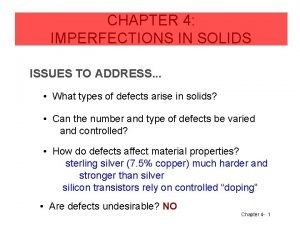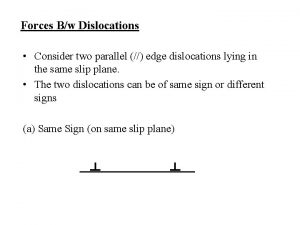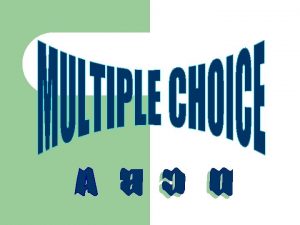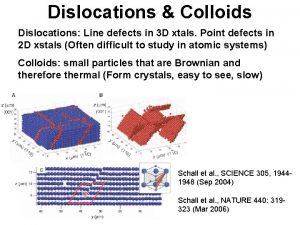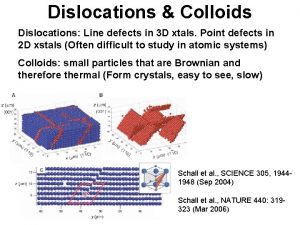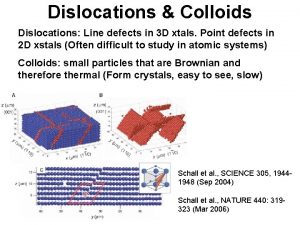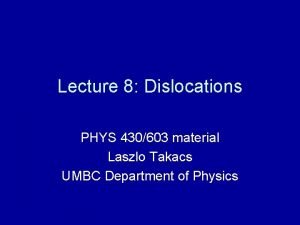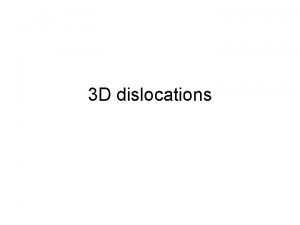Dislocations Initial overview Material w NO dislocations is












- Slides: 12

Dislocations - Initial overview Material w/ NO dislocations is very strong But it cannot be deformed plastically Dislocations weaken a material But dislocations make plastic deformation possible

Dislocations - need to control slip Ease of disloc movement along slip planes is key to ductility Easier movement along slip planes means greater ductility Well-defined slip planes are best for easy motion flat!!

Brief description of metal crystal structures Most metals exhibit one of three very simple types of atom arrangements (crystal structures): 1. cubic close-packed (ccp) 2. hexagonal close-packed (hcp) close-packed structures built up of atom layers like this Stacking of layers different for cubic or hexagonal

Brief description of metal crystal structures Most metals exhibit one of three very simple types of atom arrangements (crystal structures): 1. cubic close-packed (ccp) 2. hexagonal close-packed (hcp) 3. "body centered cubic metal structure" ("bcc") No close-packed layers in "bcc"

Brief description of metal crystal structures Just for fun……here are several views of the structure of a sodium silicate zeolite – a somewhat complicated crystal structure

Brief description of metal crystal structures Where are mostly densely packed planes in these three crystal structures? 1. cubic close-packed (ccp) 2. hexagonal close-packed (hcp) 3. "body centered cubic metal structure" ("bcc") four

Brief description of metal crystal structures Where are mostly densely packed planes in these three crystal structures? 1. cubic close-packed (ccp) 2. hexagonal close-packed (hcp) 3. "body centered cubic metal structure" ("bcc") four one

Brief description of metal crystal structures Where are mostly densely packed planes in these three crystal structures? 1. cubic close-packed (ccp) 2. hexagonal close-packed (hcp) 3. "body centered cubic metal structure" ("bcc") four one six

Dislocations Slip planes are most densely packed planes in crystal structure Disloc movement easier in simple crystal structures cuz slip planes well-defined

Dislocations Metals are so useful in our society because they have simple crystal structures Metals are so useful in our society because they can be plastically deformed Can be plastically deformed because dislocations can move easily Can move easily because the slip planes are well-defined Slip planes well-defined because metals have simple crystal structures

Dislocations Problem: as material deforms, dislocs disappear - at surface, at grain boundaries, elsewhere If dislocs disappear completely, mat'l becomes extremely strong & no longer ductile Never happens…… Instead, more dislocs produced during deformation!! Highly deformed mat'l contains BILLIONS of dislocs Undeformed – 106 lines/cm 2 Deformed – 1012 lines/cm 2

Dislocation generators at work! Internal generators act to constantly generate new dislocs during deformation
 Dislocations in crystals
Dislocations in crystals Consider two edge dislocations of opposite sign
Consider two edge dislocations of opposite sign Geometrical symbol
Geometrical symbol Example of material culture
Example of material culture Material price variance formula
Material price variance formula Matter useful and harmful
Matter useful and harmful Culture includes
Culture includes The knowledge language values customs and material objects
The knowledge language values customs and material objects Which animal refuses to become excited about the windmill
Which animal refuses to become excited about the windmill Nursing diagnosis
Nursing diagnosis Initial elpac scale score ranges
Initial elpac scale score ranges Scenario ideas
Scenario ideas Block style memorandum
Block style memorandum
